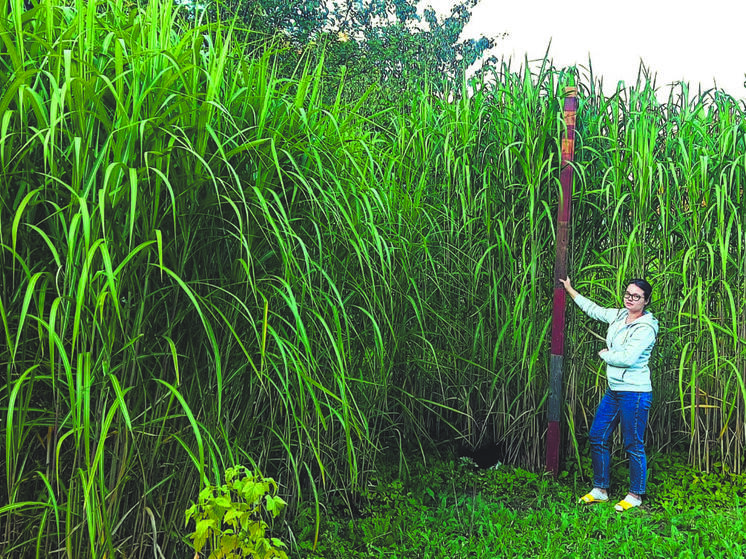«Grows up to three meters»
Domestic scientists are introducing a new crop into agriculture — miscanthus. This herbaceous plant is used to produce cellulose. Unlike wood, which is currently involved in this process, processing miscanthus is not only more convenient and faster technologically, but also significantly cheaper.
 A noble miscanthus is grown by a farmer near Moscow.
A noble miscanthus is grown by a farmer near Moscow.
The processing of the exotic herbaceous crop, which is being introduced by specialists from the Institute of Cytology and Genetics of the Siberian Branch of the Russian Academy of Sciences, is so far carried out only at one pilot plant in the Moscow region. At the same time, a wide network of enterprises for the production and processing of this perennial plant is already being formed in Russia. In particular, a site has been identified for the creation of such an enterprise in the Novosibirsk region, and an agreement has been reached on the creation of a similar plant in the Kaliningrad region.
According to scientists, miscanthus is quite undemanding to grow, although it prefers moist soil. One hectare of plantations of this plant can produce up to four tons of cellulose. Making cellulose from wood is technologically much more complex and expensive. In addition, according to industry specialist, host of the “Rural Hour” program Igor Abakumov, miscanthus has another important advantage, since it is a renewable raw material.
Only leaves are processed into plant cellulose to make disposable tableware, which, unlike plastic, is completely biodegradable. Miscanthus grows quite quickly, and, importantly, its plantations can be established in almost any conditions, including landfills. “If miscanthus is planted next to some environmentally unfavorable plant, then no European fines for CO2 emissions will threaten such an enterprise, since this miracle plant will neutralize all negative industrial emissions,” the expert notes.
< p>The media is already expressing a certain distrust in the capabilities of the domestic agro-industrial complex to quickly master such a new agricultural crop for us. After all, as you know, a Russian man takes a long time to harness, although he drives quickly. But, as it turns out, nothing lasts forever under the moon.
There is a farmer in the Moscow region who has been growing miscanthus since 2019. The head of a peasant farm from the Serebryano-Prudsky district, Sergei Padalok, says that he had his first experience with miscanthus four years ago, when he planted 25 acres of this crop near the village of Dmitrievka, and now he is growing it in two places with a total area of 10 hectares.
“The crop is not capricious at all, it grows quickly, like bamboo, but the harvest must be harvested after three years,” he explains. — Miscanthus grows up to 3 meters, it is a perennial crop, producing crops on one area for 30 years.
— From 15 to 18 tons, that is, about 170 tons from a small piece of land. In total, you can get 40 tons of cellulose from them.
“I started to engage in this culture myself. Now I have a sponsor. He enters into contracts with a paper mill to produce packaging board from raw materials. In general, the use of cellulose is very wide. Fuel briquettes that, when burned, practically do not emit carbon dioxide. Bioconcrete is building blocks. Instead of wood chips, the panels are filled with miscanthus, which does not rot and retains heat well. Disposable tableware — cups, bowls, mugs. Unlike plastic, they decompose in the soil and do not harm the environment. In terms of saving the planet from global warming, this is an irreplaceable crop that leaves no carbon footprint. One hectare of miscanthus releases 5 times more oxygen into the atmosphere than one hectare of forest.
— “Pulls out” heavy metals from it, makes it more fertile, accumulates organic substances. In addition, dense thickets of miscanthus are a good refuge for fauna. There is high humidity and little sun, on my 10 hectares I saw traces of wild boars and roe deer…
In general, the crop is extremely promising for Russia. Especially taking into account the social movement for “green energy” that has unfolded in the world. As you know, under various environmental protocols, in particular the Paris Protocol, by 2030 the planet intends to completely abandon the use of coal, which “warms up” the Earth. And by 2050 — completely from gas and oil. Switch to the use of renewable energy sources: Sun, water, wind, and, probably, miscanthus.
Where else are there millions of hectares of free land, if not in Russia? However, some experts fear that it may, like hogweed, spread throughout Russia, and we will get a big problem. A farmer near Moscow completely excludes this option. Miscanthus does not have seeds that hogweed scatters around itself, since it is planted with a root system. In short, we won’t get a new weed, but salvation from global warming is possible.


